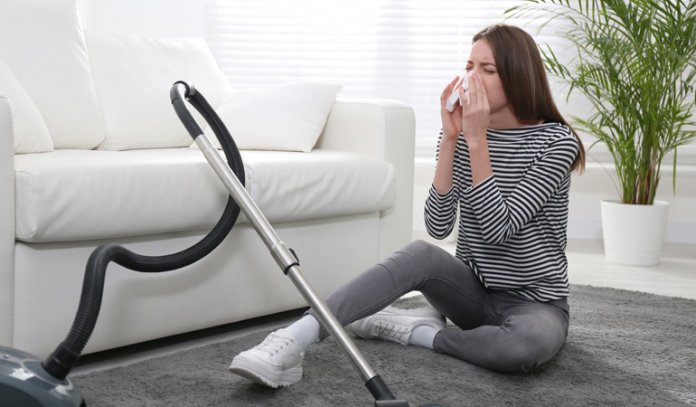Do you or someone in your family suffer from allergies? Use these room-by-room cleaning tips to get an allergen-free home. You’ll love the relief they provide.
Contents
Use the Right Cleaning Tools to Reduce Allergens
Using the wrong cleaning tools only moves allergens from one surface to another. If you want relief, you need to get the allergy triggers out of your home. Be open to the idea that you might need to change how you’ve been doing things.
Some traditional cleaning tools, like feather dusters and brooms, stir up dust. To dust your home correctly, switch to methods that actually get rid of it. A damp cloth — rinsed often — is far better. Microfiber cleaning cloths are the best of all since they have dirt-catching bristles. An electrostatic dry mop works better than a broom on floors. And to get the most dirt and dust out of your home, use a vacuum cleaner, even on hard floors.
Standard household cleaning products can make allergy problems worse, too. Aerosol formulas add irritating fumes to indoor air, and so does chlorine bleach. Even non-aerosol products can cause allergy-like symptoms. Skip cleaners containing sodium laurel sulfate (SLS), sodium hypochlorite, D-limonene, ammonia, or formaldehyde. And if the product label doesn’t state ingredients, skip it altogether. Choose cleaners with few ingredients or, even better, use homemade natural cleaning products.
Room-Based Cleaning Tips for Allergy Sufferers
Avoiding allergy triggers isn’t always enough. Some sources of allergens aren’t obvious, so they’re overlooked. This room-based list of cleaning tips for allergy sufferers helps with those.
Practice Bedroom Hygiene
Choose the right bedding. Bedding collects a lot of dust mites as well as pet and human dander. This makes it a huge source of irritants for allergy sufferers. Make sure fabrics used in your bedroom are washable, including your bedspread. To kill allergens, you’ll need to launder bedding in hot water that’s at least 134°F/54°C. Wash sheets and pillowcases weekly, comforters and duvet covers monthly, and pillows every three months. Make a point to deep-clean your mattress twice a year, too.
Allergy-proof your window treatments. Swap horizontal blinds for washable roller shades if you can. Otherwise, vacuum blinds weekly with a dust attachment. Wash your curtains or drapes every three months. You might also want to vacuum them with a dust brush between launderings, especially if you have pets. Also, hang curtains high enough that they don’t pool on the floor collecting dust.
Speaking of pets, allergy experts recommend banishing them from the bedroom altogether. If you can’t bear that thought, make a habit of brushing or wiping pets outdoors at the end of the day. (I use these wipes* on my dog, and they’ve done wonders to ease my allergies and hers, too.)
Don’t let your clothes gather dust. Put dirty clothes into a covered hamper, rather than dropping them on the floor. And keep both your closet and dresser drawers closed, so dust in the air doesn’t wind up on your clean clothes.
Shut windows during the pollen season. If you don’t have central air in your home, a window unit in your bedroom can ensure eight hours of allergy relief. During the rest of the year, open windows daily for 10-15 minutes to let in the fresh air and prevent mildew.
Bathing before bed is about more than relaxing. It also washes away any pollen in your hair or on your skin, so you don’t wind up spreading that in your bed. Be sure to completely dry off before you get into bed. Going to sleep with wet hair won’t cause a cold, but it could lead to a moldy pillow that’ll make you cough and sneeze.
Most of the things we do in bathrooms involve water and quite often steam. This makes bathrooms prone to mold and mildew and causes allergy symptoms to flare.
Keep towels free of mildew. Spread towels unfolded across towel racks after bathing, so they can completely dry. If that’s not possible, then change your towels every other day at least. Keeping damp towels in your bathroom leads to mildew on them and other surfaces, too.
Keep moisture from building up in your bathroom. Run your exhaust fan during your shower and 10-15 minutes after you’re done. If you don’t have a bathroom fan, use a battery-operated stand-alone fan to circulate air.
Don’t trap moisture in your bathroom, either. Carpets don’t belong in the bathroom. They collect mold, mildew, and other things no one wants to think about. Using washable throw rugs and bath mats is more hygienic. Launder them weekly in hot water. Also, hang up bath mats between uses, so they dry.
Stay on top of repairs. Replace broken or cracked grout if you find any, so moisture doesn’t seep into your walls or subfloor. Completely scrape away any damaged caulk and replace it, too — it’s an easy task that takes under an hour.
Tidy daily, clean weekly. Keeping surfaces dry helps control allergens in the bathroom. So, it’s a good idea to tidy up daily by wiping your faucets, sink basin, and vanity as part of a daily cleaning routine. Then, once a week, clean your entire bathroom and disinfect it to kill mold spores.
Control Your Clutter
Clutter collects dust and attracts pests, which can make allergy symptoms much worse. It also makes cleaning your home more difficult, so allergens get out of control.
Reduce dust by redecorating. The fastest way to reduce clutter is by cutting down on how many decorative items you have sitting out. You don’t have to toss your favorite collections, though. Put them in glass cabinets so they’re visible but not gathering allergens. Or rotate the decor you display throughout the year.
Switch to hard-sided containers. Cardboard boxes absorb moisture which can lead to mold and mildew. Boxes are also a favorite nesting spot and food for pests. Switch to hard-sided plastic totes with air-tight lids for long-term storage. They’re more protective but easy to clean, so they’re much more allergy-friendly.
Living or family rooms, media rooms, and rec rooms are other spots where we tend to hang out at home. Since we spend so much time in these areas, it’s important to clean them properly to reduce allergens.
Vacuum often. Like any room in your home, these areas need weekly wall-to-wall vacuuming. If you have pets or you allow food in your living areas, you need to vacuum beneath seating and tables weekly, too. Then every day, go over high-traffic areas and seating surfaces to remove dust and pet dander.
Know how often to dust things. Dust ceilings, ceiling fans, and walls monthly using an extension duster. Use it to dust your baseboards every other week, too. Clean hard furniture with a damp microfiber cloth weekly and tabletops every day. The more you do to reduce dust in your home, the fewer allergy symptoms you’ll have.
Plants can be problematic. Many people with allergies avoid live plants. But even fake plants must be cleaned regularly to reduce allergens. If you want to keep real plants, wipe their leaves monthly to remove dust. Don’t overwater them, or you’ll wind up with mildew in the soil and mold in the overflow container.
Clean These Kitchen Spots
For food allergies, listen to your health care provider about ingredients to avoid. For cleaning tips to keep other types of allergens in the kitchen under control, read on.
Run your stove hood fan. Run your exhaust fan when you’re cooking to remove fumes and moisture from the air. Be sure to wash your range exhaust fan’s filters at least once a month to keep them in good working condition.
Keep these gaskets clean. Your refrigerator, dishwasher, and garbage disposal all have rubber gaskets. These keep moisture inside the appliance to protect the rest of your kitchen. But these gaskets also get moldy if you don’t clean them at least once a month. It takes mere minutes to pry them open with your fingers and wipe them with a soapy rag and then a dry cloth.
Line your cabinet tops. A sheet of wax paper laid on your kitchen cabinet tops makes it easy to eliminate collected dust. Once a month or so, wad up the paper and replace it. Try to keep your cabinet tops clear, too. If you can’t stand them bare choose decorations that you can run through the dishwasher.
Use a trash can with a tight-sealing lid. Open trashcans in the kitchen fill your home with irritants and odors. Use a can that seals and empty it daily, even if the bag is not full, to avoid attracting pests. Wash your trash can at least once a month or any time you see a bag has leaked.
Check the Basements and Laundry Room
A damp, dusty basement is a nightmare for allergy sufferers. Lint-coated laundry rooms aren’t much better. Both spots are high-humidity areas, so you’ve got to be vigilant about preventing mold.
Clean up spills immediately. Even a small splash of liquid can seep through your basement flooring and grow m old. In the high humidity of a laundry room, that same small splash could take days to dry. Meanwhile, it’ll develop mildew and irritate allergies.
Circulate air as often as possible. If your basement has windows or doors, open them on mild days so air can circulate and dry out damp, humid spots. You’ll find your entire home smells better when your basement’s air is fresh. Use fans to circulate the air on cooler days or in windowless basements.
More Allergen-Reducing Cleaning Tips
Keep humidity in check. Dust mites and mold love warm, humid air. To keep these allergy-triggers in check, aim for a temperature range of 68°F (20°C) to 72°F (22°C) with a humidity level of 50-60%. You can also keep it in the sweet spot with methods to keep warm in winter without heat or to cool your home without AC.
No smoking indoors. Smoke produces a combination of allergens and irritants that can make asthma worse. It also leaves a film on walls and furnishings that is difficult to clean. It’s not enough to banish indoor cigarette smoking. If something produces smoke, it produces allergens. That goes for your fireplace, candles, or vaping. Take it outside.
Practice good pet care. Pets that spend time outdoors shed less dander in the house but bring in more pollen. Lessen your symptoms by brushing them outside and bathe them regularly. Wash pet bedding weekly to get rid of collected dander and pollen, too.
Keep your entrances clean. If your front step or back patio is dusty, anyone walking on them will track that dust into your house. Sweep daily during pollen season and at least once a week for the rest of the year.
Banish shoes in the house. Wearing shoes in your home tracks in dust, pollen, and other allergens from outdoors. Have a no-shoes policy, or make sure everyone in the family has a pair of house shoes. Your floors will stay cleaner longer, too.
Get rid of carpeting everywhere you can. Carpets are a hotbed of allergens, and their pads act like sponges for any excess humidity in your home. If you can’t switch to hard flooring, vacuum correctly and often enough. Make sure your vacuum has a HEPA filter, so it doesn’t release allergens into your air. Wash and replace filters as needed according to the manufacturer’s directions.


